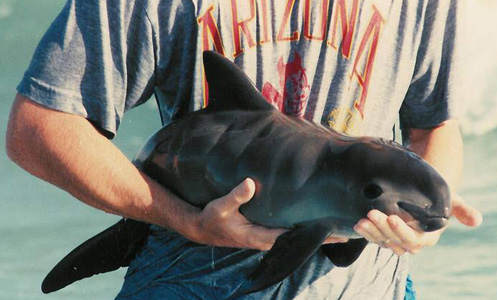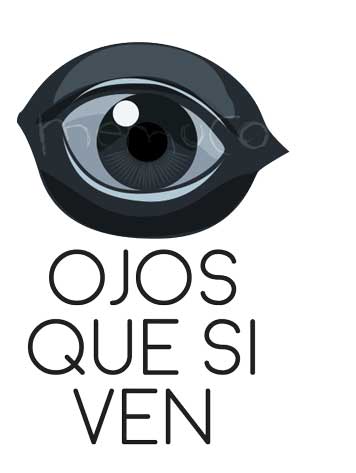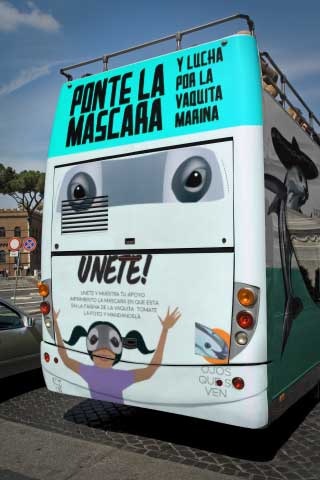
A New Hope for the Vaquita
| SCB's Marine Section rises to challenge of saving Mexico's critically endangered vaquita. |
 |
|
©CEDO Intercultural: In Our Hands: a vaquita calf that was found and brought to CEDO Intercultural in 1994. (See UPDATES on the vaquita efforts near the bottom of this page. The new 2015 vaquita report was highlighted by the NY Times. Most recently, we have a new ambassador lending her efforts to the vaquita - read our update here!) |
|
Critically endangered vaquitas in Mexico need our help finding a spokesperson. If you are interested in contributing to this task, click HERE to see the info in English or HERE for Spanish. |
|
-------------------------- Donate to fundraising efforts that will help support enforcement actions needed to save the vaquita. No contribution is too small. ------------------------------- |
The Marine Section has also partnered with The Marine Mammal Center to administer public donations. If you wish to donate to fundraising efforts to in support of the enforcement actions needed to save the vaquita, please click here.
Update: SCB supports gillnet ban for the benefit of the vaquita, an important first step towards the conservation of the smallest cetacean species
by SCB Marine Policy Officer Andrew Wright, with translated texts by Policy Committee Member Mel Cosentino, SCB LACA Board Member Sandra Pompa Mansilla and Lorenzo Rojas-Bracho
Since the end 2012, when SCB Marine partnered with the European Cetacean Society and the Society for Marine Mammalogy to write to the Mexican Government about the vaquita (see here), the only changes have worsened the situation. Lack of enforcement of the vaquita reserve has been combined with a resurgence in illegal fishing for the endangered totoaba throughout the region over the last couple of years. The totoaba are taken only for their swim bladders, while the rest of the body is discarded. These bladders are dried and illegally shipped mostly to China (more info on that is available here).
The latest CIRVA report from July 2014 made it clear this resurgence had accelerated the vaquita decline and reduced the population to fewer than 100 animals. The Mexican Government immediately announced that they would respond to the recommendations made in the CIRVA. And the world waited. Promised announcement dates came and went, and the season for legal shrimp fishing, which has been a driver of the long-term vaquita declines, opened while there was still no announcement.
SCB Marine, in cooperation with SCB LACA, decided to act and started gearing up the machinery for another letter urging action. Unexpectedly, just as the letter was being finalised, the Mexican Government announced that it would indeed be taking action. And just in time for Christmas.
Seeing an opportunity to be encouraging, SCB Marine and SCB LACA reworked the letter with SCB LACA, supporting the ban while noting several improvements to the plan. The new letter was ultimately sent to responsible Mexican officials and submitted directly into the Mexican regulatory process for the proposed ban during the open comment period (available here in both Spanish and English, with the regulatory responses here and with relevant sections in English here).
Despite the fact that some concerns remained (especially regarding the allowed corvina fishery), the proposal was ultimately successful (available here with supporting documents here, with English translations of the agreement and the supporting docs here). Signed into force on the 17th Feb (see here, Spanish only), the agreement was launched in a press conference on the 27th Feb, 2015 in Mexico City (English translation available here, and see here for more information).
Originally supposed to come into force on the 1st March, 2015, it appears that the ban will now not take force until 1st April. Thus, while this two-year gillnet ban is an extremely welcome development, it comes after nearly one full additional year of fishing, which is expected to have pushed the vaquita even closer to extinction. The enforcement of the ban (which remains uncertain) will buy time to develop long-term solutions. To that end, SCB Marine and SCB LACA continue to work with many other governmental and non-governmental agencies seeking to find those long term solutions.
How can you help? Simply spreading the word about the plight of this animal, especially in Mexico, China and USA. If you want to do more, you can follow various websites to keep up with the current state of affairs:
- http://vlogvaquita.com/
- https://www.facebook.com/vaquitaarebrowncoats (with added Sci-Fi thrown in)
- http://www.vivavaquita.org/
- http://vaquita.tv/
Financial donations to aid conservation efforts and outreach can be made to the fund SCB Marine has contributed to at The Marine Mammal Center.
In May 2015, SCB asked China to block illegal sales of totoaba, which threaten persistence of vaquita porpoise. More information can be found at this SCB Global Policy page.
Finally, if you would like to contribute in a more active way, please contact Marine’s Policy Officer Andrew Wright (marinebrit (at) gmail.com).
Update 10/2015: New Ambassadors for the Vaquita
.jpg) Drawing inspiration from the new SCB Working Group on Conservation Marketing and Engagement, the Marine and LACA Sections put out a call in late 2015 for help over social media: we needed people living and working near vaquita-inhabited areas to help us find new ways to reach the people of the region. Monica Michelle Medina answered our call and, after discussions, joined our efforts to save the vaquita.
Drawing inspiration from the new SCB Working Group on Conservation Marketing and Engagement, the Marine and LACA Sections put out a call in late 2015 for help over social media: we needed people living and working near vaquita-inhabited areas to help us find new ways to reach the people of the region. Monica Michelle Medina answered our call and, after discussions, joined our efforts to save the vaquita. |
.jpg) |
 |